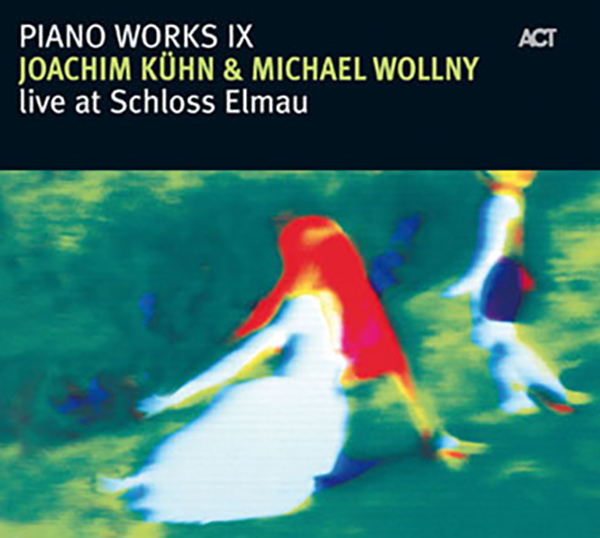
by Ian Mann
March 02, 2009
/ ALBUM
This remarkable document is a "must hear" not just for hardcore piano fans but all lovers contemporary jazz
The latest item in ACT’s ongoing “Piano Works” series is this memorable concert recording by these two German giants of contemporary jazz piano. The duo were performing as part of ACT’s “Jazz And Friendship” festival at Schloss Elmau in September 2008 and label boss Siegfried Loch, sensing that something special might happen in this unusual twin piano configuration, had the prescience to ensure that the concert was recorded with a view to future release. The music Kuhn and Wollny produced must have exceeded even his expectations and this memorable document is a must hear not only for hardcore piano fans but lovers of contemporary jazz in general.
The combination of Kuhn (born 1944) and Wollny (born 1978) spans the generations but the understanding between the players is immediate and empathic. It is perhaps no surprise that Wollny wrote his music college thesis on aspects of Kuhn’s approach to improvisation. The older man has been an important figure on the European jazz scene for many years and has recorded for ACT before including the solo piano “Allegro Vivace” (Piano Works I) back in 2003. Hitherto he has steadfastly avoided the two piano format (apart from a 1975 excursion into the genre with Martial Solal) so his involvement here is a mark of the respect he holds for Wollny.
Wollny is best known as the pianist with the exciting young trio {em} who have now released three albums for ACT, each one a clear development from it’s predecessor. In another cross-generational collaboration he has released two duo albums for ACT with tenor saxophonist Heinz Sauer and last year came his brooding, “Gothic” solo album “Hexentanz” (Witch’s Dance).
The most remarkable thing about “Live At Schloss Elmau” is the spirit of co-operation between the players. Despite their formidable technical abilities there is no grandstanding, no attempting to outshine the other player. Instead they combine to create something more substantial, resulting in some wonderfully melodic music possessed of moments of real beauty. The “Jazz And Friendship” label attached to the festival was particularly appropriate when applied to the partnership of these two masters of the keyboard. The pair “keyed in” to each other by rehearsing the night before the gig and agreed to deploy Kuhn’s harmonic concept the “diminished-augmented system”. The results suggest that the duo’s level of preparation was just right, with enough structure for the music to be coherent but without sacrificing that degree of spontaneity that makes for exciting improvisation.
In a programme of six pieces each pianist played a solo performance each, Wollny performing his composition “Elmau”, inspired by the concert’s location and Kuhn offering his interpretation of J.S.Bach’s “Chaconne”.
However the concert commenced in duo mode with Kuhn’s brooding but beautiful “The Colour Of The Wind”, a brief introduction to the duo’s intuitive interplay on their two Steinway Grands. This segues into an extended version of Wollny’s “Hexentanz”, the title track of his recent solo album. The duo version is less dark and self consciously “Gothic” than the original recording. It does however offer some dazzling, technically brilliant interplay between the participants, the interlocking lines and tumbling rhythms punctuated by oases of calm. Constantly shifting in mood and pace, but always organically so, the piece is a tour de force and arguably the centre piece of the album.
Wollny is the first of the two to perform solo. His “Elmau” demonstrates the lyrical side of his playing and is almost hymnal at times. However there is also a playful element and great technical facility in the way he deploys the entire keyboard over the course of the piece.
Kuhn’s solo feature sees him leisurely exploring the complexities of Bach’s “Chaconne”. Initially languid but gaining in urgency as the piece reaches it’s conclusion Kuhn’s interpretation remains true to the spirit of the album as a whole and exhibits the customary technical expertise we have come to expect from these inspirational players.
The following “Seawalk”, credited to Kuhn sees the return of the duo format. The two pianists engage in ruminative musical conversation, gently trading phrases before the discussion becomes more animated, coalescing in a common musical statement.
The closing “Encore” is jointly credited and features another wonderful dialogue between these two great musical minds. The interaction here is as strong as anywhere on the album. Kuhn and Wollny remain in keeping with the ethos of the project until the end. Even on the encore they resist any grandstanding or throwaway gestures.
The reactions to both the concert itself and to this recording have been overwhelmingly positive with critics unanimous in their praise. The chemistry between the players is palpable and although the music is technically challenging for the players it is never “difficult” for the listener.
As the word begins to spread ACT may find that this remarkable recording becomes their equivalent of Keith Jarrett’s legendary “Koln Concert”.
“Live At Schloss Elmau” really is that good. Highly recommended.
blog comments powered by Disqus